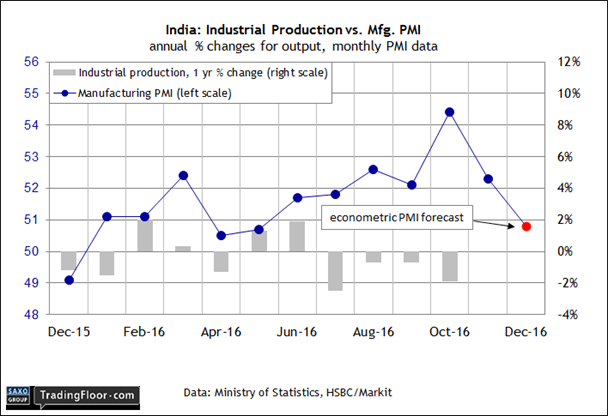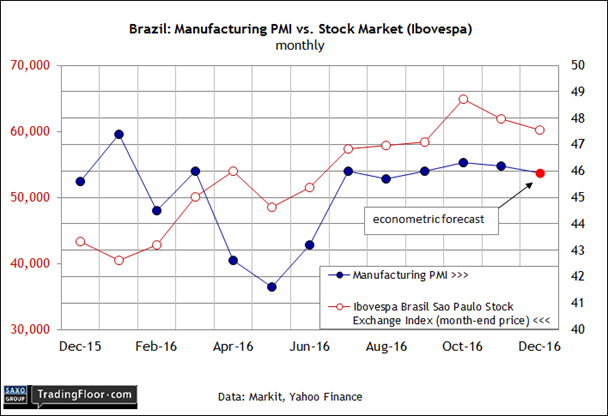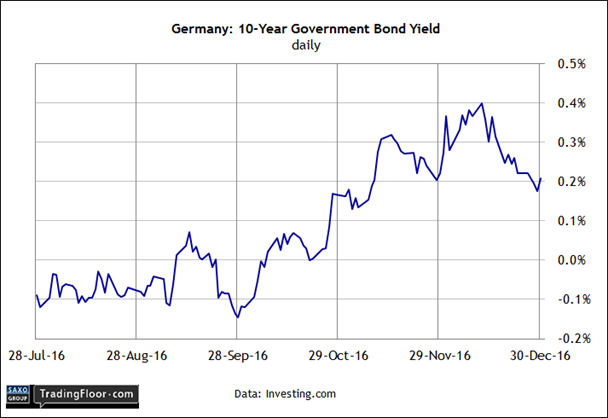- India's banknote shortage crisis will weigh on its December Manufacturing PMI
- Brazil’s Manufacturing PMI for December will give clues on its economic recovery
- The decline of Germany’s 10-year yield may be a sign of what to expect this year
With several countries on holiday today, the first trading day of the year will be a quiet affair. Economic news is primarily centred on survey updates, including the first look at manufacturing PMIs for India and Brazil in December. Meantime, keep an eye on the German 10-year yield, which has reversed course recently after rising sharply in October and November.
India: Manufacturing PMI (0500 GMT): India’s poorly designed program to remove large banknotes from its financial system continues to pinch the economy and relief isn’t expected in today’s survey numbers for the manufacturing sector.
In time, so-called demonetisation has the potential to transform the economy for the better, the central bank asserted last week. But the Reserve Bank of India’s governor, Urjit Patel, admitted that the price tag is “short-term disruptions in certain segments of the economy and public hardship” in an economy that’s heavily dependent on cash transactions.
The services sector has suffered the most, according to survey data for November. The Nikkei India Services PMI fell sharply, tumbling from a moderate growth pace to a slightly contractionary reading. “The latest set of gloomy PMI figures for the Indian service sector shows that companies were heavily impacted by the 500 and 1,000 rupee notes ban,” an economist at IHS Markit said last month. “Cash shortages resulted in fewer new business intakes, which in turn caused a fall in activity and ended a 16-month sequence of expansion.”
The Nikkei India Manufacturing PMI is doing better, although growth eased in November. The setback is attributed to demonetisation, which has squeezed orders and output.
The fallout is expected to continue in today’s December update for the manufacturing sector. TradingEconomics.com’s econometric forecast sees the PMI slumping to 50.8 – just above the neutral 50 mark – for last month’s reading. If accurate, today's update will be the lowest in more than a year.
Manufacturing growth, in other words, is hanging by a thread. A revival is expected at some point, once the blowback from demonetisation clears. Timing, however, remains a mystery. Meantime, the fallout from a major policy error will continue to sting this formerly high-flying economy.

Brazil: Manufacturing PMI (1200 GMT): Brazil’s economy had a rough year in 2016, but signs of recovery have stirred hope that the recession’s end is in sight. But the positive momentum has reversed lately, raising new questions about what’s in store for 2017.
One clue that expectations have suffered lately: the Consumer Confidence Index dipped in December to its lowest reading since June. “The year ends with consumers dissatisfied with the present situation and pessimistic about the coming months,” an economist at the Getulio Vargas Foundation (FGV) said in last month’s release. “The assessment on [the] labour market is the worst in the last 11 years; projections for inflation are still high and household indebtedness makes it even more difficult to build a favourable scenario.”
Another survey finds that the outlook has turned cloudy again, based on FGV’s Economic Uncertainty Indicator, which has increased for a second month in December. “The result confirms a reversal of the downward trend observed between July and October, and the return to a period of high economic uncertainty in Brazil,” the research group noted in a press release.
Brazil’s stock market has turned cautious too. After rallying for much of 2016, the bullish tide peaked early in the fourth quarter. Although the Bovespa Stock Index was up sharply on the year, the market shed 7% in the final two months of 2016.
Today’s December update on sentiment in the manufacturing sector isn’t expected to revive the outlook. TradingEconomics.com’s econometric forecast sees the Manufacturing PMI slipping a bit deeper into negative territory (below the neutral 50 mark).
What will change the outlook for the better? Much depends on resolving the ongoing political crisis and passing reforms for repairing the government’s troubled finances, an FGV economist explained last week. “Only then will the country be able to start putting itself back together.”

Germany: 10-Year Bond Yield: Maybe the era of low interest rates isn’t over after all. Europe’s benchmark 10-year rate fell in the second half of December after peaking at around 0.4%. By the end of last month, the rate had slumped to just above 0.2%.
Analysts are struggling to determine if the latest slide is noise or a signal that interest rates in Europe are set to resume the downward trend that prevailed before Donald Trump’s election in November triggered a rise in yields around the world.
“Normally the yields are very highly correlated between the US and Germany but we've actually seen a divergence where Treasury yields have continued to inch higher but bunds [prices] have rallied and yields have gone in the opposite direction,” the chief investment strategist at Prudential observed last week.
The decline in the German 10-year is a bit puzzling in the wake of upbeat projections for Eurozone GDP growth in the fourth quarter. Last week's Euro-Coin Indicator’s estimate ticked up to a 0.59% quarterly rise through December, the highest in more than five years and double the pace in Q3.
Germany’s economy is also on track to expand at a moderate pace, picking up a bit after a summer slowdown, according to recent survey data. “December’s flash PMI signalled a strong end to the year for German private sector firms,” an IHS Markit economist advised recently. “With readings for October and November also pointing to marked output growth, the data suggest that the rate of GDP expansion is likely to have accelerated in Q4 from the disappointing 0.2% in the third quarter.”
What then, accounts for the latest jump in bond prices (and commensurate decline in yield) for Germany’s 10-year bund? Diverging monetary policies in Europe vs. the US is a factor. The European Central Bank is still focused on quantitative easing while the Federal Reserve is raising interest rates.
The political outlook is another influence. With populism on the rise across Europe, parliamentary elections in 2017 could create turbulence as mainstream parties struggle to hold on to power and set the agenda. Following this logic implies that a renewed appetite for safety will drive yields lower as a hedge against political uncertainty.

Disclosure: Originally published at Saxo Bank TradingFloor.com
